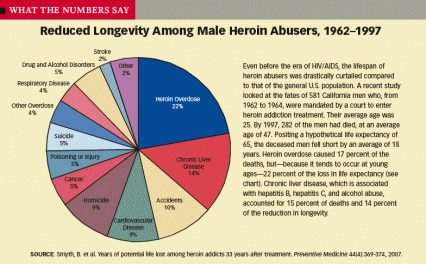 Even before the era of HIV/AIDS, the lifespan of heroin abusers was drastically curtailed compared to that of the general U.S. population. A recent study looked at the fates of 581 California men who, from 1962-1964 were mandated by a court to enter heroin addiction treatment. Their average age was 25. By 1997, 282 of the men had died, at an average age of 47. Positing a hypothetical life expectancy of 65, the deceased men fell short by and average of 18 years. Heroin overdose caused 17 percent of the deaths, but - because it tends to occur at young ages - 22 percent of the loss of life expectancy. Chronic liver disease, which is associated with hepatitis B, hepatitis C, and alcohol abuse, accounted for 15 percent of the deaths and 14 percent of the reduction in longevity.
Even before the era of HIV/AIDS, the lifespan of heroin abusers was drastically curtailed compared to that of the general U.S. population. A recent study looked at the fates of 581 California men who, from 1962-1964 were mandated by a court to enter heroin addiction treatment. Their average age was 25. By 1997, 282 of the men had died, at an average age of 47. Positing a hypothetical life expectancy of 65, the deceased men fell short by and average of 18 years. Heroin overdose caused 17 percent of the deaths, but - because it tends to occur at young ages - 22 percent of the loss of life expectancy. Chronic liver disease, which is associated with hepatitis B, hepatitis C, and alcohol abuse, accounted for 15 percent of the deaths and 14 percent of the reduction in longevity.Source
Smyth, B. et al. Years of potential life lost among heroin addicts 33 years after treatment. Preventive Medicine 44(4):369-374, 2007
